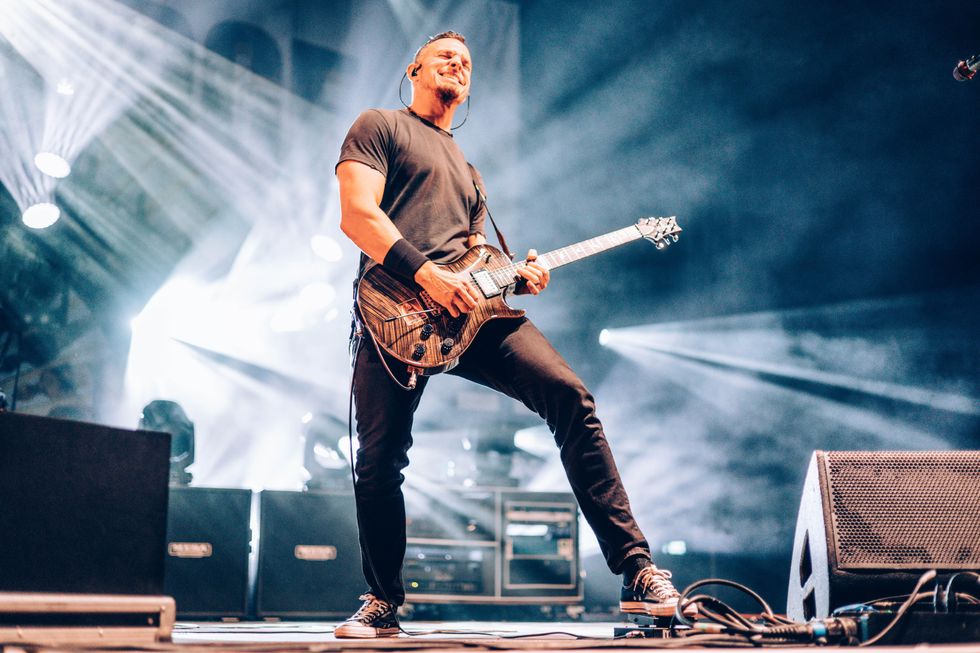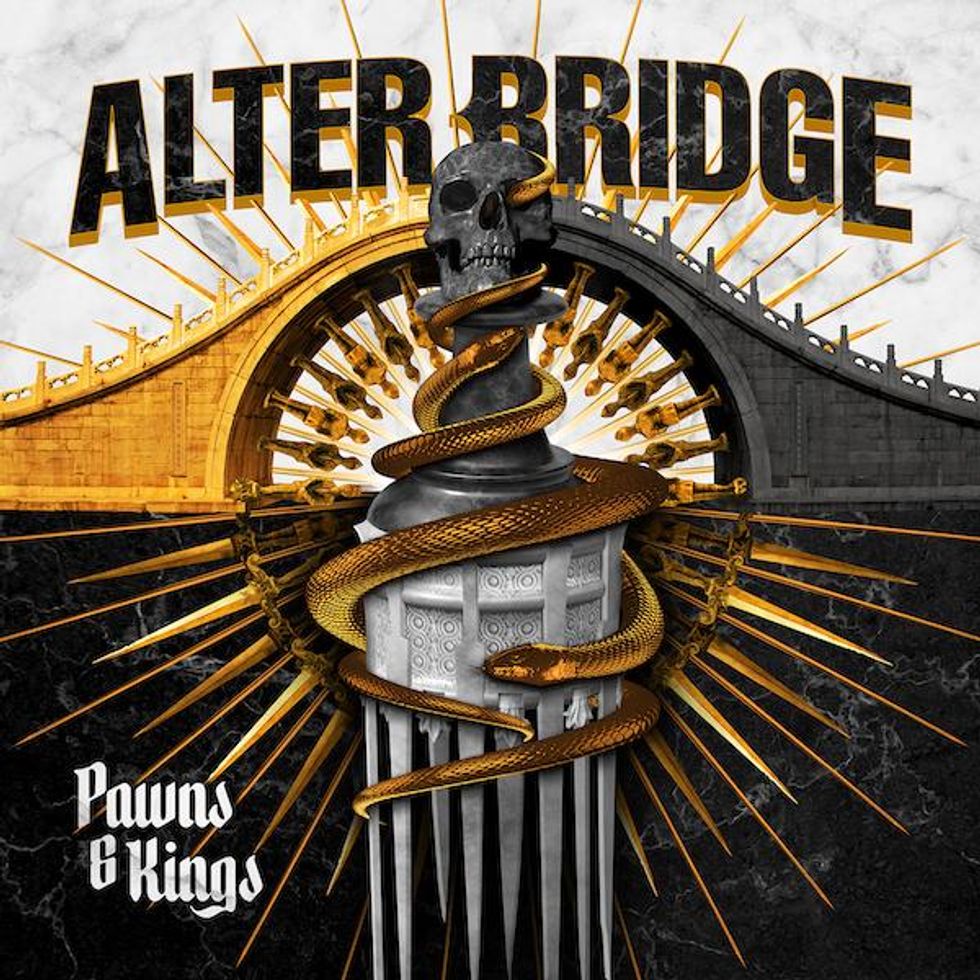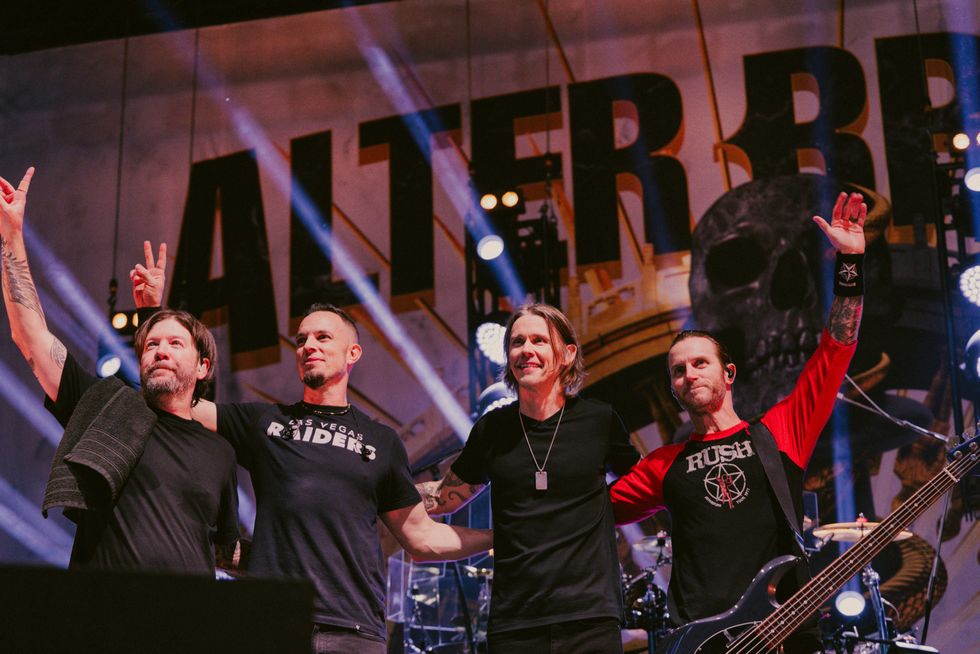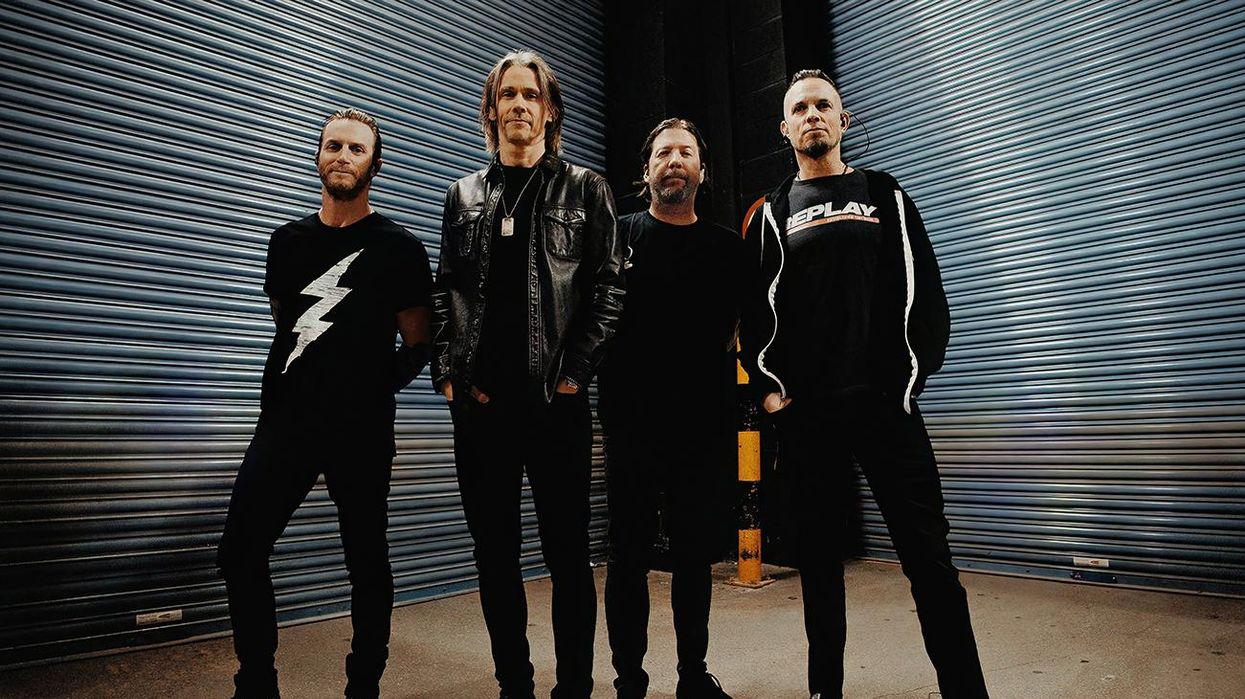On top of having all the trappings of an epic rock band, Alter Bridge, who’ve just released a new album called Pawns & Kings, has the necessary talent and magnetism to back them up. Just look at the lineup: Their charismatic frontman, singer/guitarist Myles Kennedy, is considered among the best vocalists in modern rock; guitarist Mark Tremonti is not just heroic on the instrument, but virtuosic; and together, Brian Marshall’s melodic bass playing and drummer Scott “Flip” Phillips’ Bonham-like power generate megawattage.
Tremonti, Marshall, and Phillips are also founding members of Creed, one of the biggest rock bands of the past few decades. Kennedy is the singer for Slash’s solo band. And, Kennedy and Tremonti have also been enjoying successful solo careers: Tremonti just released Tremonti Sings Frank Sinatra, recorded with Ol’ Blue Eyes’ surviving bandmembers and benefitting the National Down Syndrome Society.
Alter Bridge - Holiday (Official Video)
Clearly, Tremonti and Kennedy have their creative engines in high gear. “It’s an addiction,” Tremonti explains. “You write that song that makes your hair stand up, and you want to do it again. It’s the same with anything creative, whether writing a song or book, or painting a picture. It is like a drug.”
As Kennedy points out, the trick is balancing that addiction with the signature sound they’ve created for the past 20 years. “We’re nearly two decades in, and we have a good understanding of what boxes to check and what our fan base wants to hear. It’s that delicate dance of making sure that they’re content and that we’re also still pushing ourselves.”
“I started as a guitar player. Lead, in particular, was my big passion growing up.”—Myles Kennedy
For many fans, Alter Bridge’s second release, Blackbird, defined the band’s sound. It took everything they loved about the first record, One Day Remains, and made it bigger, darker, and more complex—epic, in a word. The title track clocks in at over 7 minutes long and pits Kennedy and Tremonti against each other in one of the best guitar duels in recent rock history. Since then, each Alter Bridge record has kept on this path, piling on more and more heavy, melodic elements. But there is a limit, and on Pawns & Kings, the band was ready to make a change.
“If you listen to some of the prior records, there were a lot of textures and elements weaving through,” explains Kennedy. “The other day, I was reviewing one of the songs from [2016’s] The Last Hero. I was listening on headphones and was like, ‘I didn’t even know that keyboard part was in there!’ We pulled all that out of this record. ‘Less is more’ was the motto.”
Tremonti adds, “We decided, ‘Let’s get back to our old way of doing things.’ We want it to be more just the guys playing their instruments. No orchestration underneath. No pads. Just us. It gives it more depth, and everything else has more room to breathe.”Alter Bridge - Pawns & Kings (Official Video)
That choice worked out in their favor, and on Pawns & Kings, Alter Bridge’s songwriting, musicianship, and crushing guitar tones are more in your face than ever. The band’s longtime producer Michael “Elvis” Baskette—who has also worked with Creed, Mammoth WVH, Sevendust, and Slash—was crucial to the creative process.
“[Elvis is] such an important element,” says Kennedy. “He’s an incredible producer. He can get great tones, and he has a really great arrangement ability. More than anything, he understands the psychology of making records. That’s so much of what this process is about.”
Baskette, who’s manned the board for Alter Bridge since Blackbird, knows exactly what the guys are capable of, and he had them dig deep. “I think it’s our densest record by far,” says Tremonti. “It’s a lot to take in on first listen.”
Kennedy adds that “we’ve integrated more of a demoing process, where each guy will go to his corner and spend time on the ideas that he feels strongest about before presenting them to the band.” He names the new track “Sin After Sin” as an example of this recent dynamic. “It was this musical bed that Mark had, and then I came up with some lyrics, melodies, and whatnot.”
“Usually, when it’s the heavy, chunky stuff, I’ll track that first, and then Myles will track a lot of his atmospheric, effected stuff.” —Mark Tremonti
Although both musicians have a similar writing process, how their diverging styles meet creates the band’s trademark sound. For Tremonti, a die-hard metalhead, it’s about exercising those tendencies outside the band while opening the floodgates for Alter Bridge. “Usually, when I write for Tremonti [the name of his solo project], I try to put on my speed-metal hat. That’s when I get to pull out all my childhood metal influences. I love that stuff, so it’s always fun. Other than that, I like to write whatever comes out.”
Kennedy tends to follow a more traditional singer-songwriter approach, as heard on Alter Bridge’s acoustic staple, “Watch Over You,” from Blackbird. But he’s not afraid to branch out, even lacing his debut solo album, The Year of the Tiger, around gritty resonator-guitar blues. But this time, one song, “Holiday,” with its old-school rock vibe, seemed like a step too far.
“I almost didn’t even present it to the band,” he admits. “I played the demo to our producer, and he’s like, ‘Oh, that’s going on the record! It’s got that swing and that swagger.’ I’m glad he helped.”Mark Tremonti's Gear

Tremonti digs into one of his PRS signature guitars, which are made from mahogany with a flamed maple top, have a thin set neck, medium jumbo frets, and PRS Tremonti Humbuckers.
Photo by Chuck Brueckmann
Guitars
- PRS Mark Tremonti Signature
- PRS Custom Baritone
- Martin acoustics
- Taylor acoustics
- Ramirez classical
Amps
- PRS MT 100 Signature prototype
- PRS MT 15 Signature
- Dumble Overdrive Special
- Cornford RK100
- Mesa/Boogie Oversize 4x12s
Effects
- Morley Mark Tremonti Wah
- Ibanez TS808HW Handwired Tube Screamer
- MXR Uni-Vibe Chorus/Vibrato
- Boss OC-5 Octave
- MXR Smart Gate Noise Gate
Picks and Strings
- Dunlop Flow 1.3 mm
- D’Addario (.011–.052)
The guitarists trade leads on tracks like “Dead Among the Living” and “Last Man Standing,” and Tremonti says they take very different approaches to the stage and studio. “I was never one of those guys who likes to stay up late at night, break out a million pedals, and experiment with tones. So, usually, when it’s the heavy, chunky stuff, I’ll track that first, and then Myles will track a lot of his atmospheric, effected stuff.”
With Tremonti and Kennedy at the top of their game as guitarists and vocalists, one constantly pushes the other, elevating the band. “Stay” stands out as an example, “because it’s a major key, it’s very anthemic, and you have Mark singing,” relates Kennedy. “He was insecure about his vocal, and I remember telling him to stop that nonsense [laughs]. His voice is great, and because I’m more of a tenor, there’s a nice blend there.
“I started as a guitar player,” Kennedy continues. “Lead, in particular, was my big passion growing up. The only reason I ever started singing was that it was easier to sing [my own songs] once I started writing them. When Mark discovered that I played lead guitar, he always pushed it. It’s the same nudging I did with him and his vocals.”

For their latest album, Alter Bridge scrapped their usual textured approach for a stripped-down-but-strong framework. “We want it to be more just the guys playing their instruments,” Tremonti declares.
"I know that everything I throw at Myles, he's capable of doing," Tremonti adds, "and he's going to fill a different sound. He's got a signature sound. It adds another layer for the band."
Guitar tone is a big deal in Alter Bridge. Tremonti was Paul Reed Smith’s second signature artist and helps design every piece of gear that bears his name. Although his PRS Mark Tremonti Signature rarely leaves his hands, a different PRS delivered Pawns & Kings’ heaviest moments. “I have a baritone that we used almost all the time,” Tremonti says. “Anything tuned low is that guitar. When I brought it into the studio, Elvis was like, ‘No shit! I used that when I recorded Limp Bizkit.’ Then, I was doing a show with Limp Bizkit, and Wes [Borland, Limp Bizkit guitarist] came over. He’s like, ‘Is that what I think it is? Is that the baritone? Shit, that’s a great guitar!’” Tremonti and PRS have also collaborated on the MT 15 amplifier. The lunchbox-style head is a favorite for its percussive high gain and clean channels. Pawns & Kings also offers the first hearing of the upcoming PRS MT 100, a 100-watt signature version that even dethroned Tremonti’s beloved Mesa/Boogie Rectifiers for the sessions.
Myles Kennedy's Gear

Myles Kennedy is a double threat: a great rock vocalist who can also shred like a maniac when called upon to do so.
Photo by Chuck Brueckmann
Guitars
- PRS SC245
- PRS Custom Singlecut
Amps
- Diezel VH4
- Diezel Herbert
- Dumble Overdrive Special
- Diezel 4x12
Effects
- Custom Audio Electronics Wah
- EHX Micro POG
- Boss RV-6
- Foxrox Octron3
- Reeves Klon clone
- Line 6 MM4 Modulation Modeler
Picks and Strings
- Dunlop Ultex 1.14 mm
- D’Addario (.011–.052)
“I just approved the final version,” Tremonti says. “The clean channel, to me, is the ultimate clean channel. I pulled out all my Fender Twins, played through them one by one, and found my favorites. But when I played them back-to-back with the MT 100, I preferred the MT 100. The third channel is the overdrive channel, and it’s badass. I wanted it to be all I’d ever want at my home, studio, and on tour. And I made the middle channel an overdriven Dumble-ish kind of thing."
Kennedy is also a PRS devotee, and has leaned on his trusty tobacco burst SC245 for years. While he did experiment with a Fender Telecaster for Alter Bridge’s 2019 Walk the Sky album sessions and tour, he’s replaced that instrument with another PRS. “There’s this one-off PRS made me last year,” he says. “It does a lot of the things I wanted it to do in the Tele realm. It’s a black Singlecut, and that is what I played on 80 percent of this record.”
“We decided, ‘Let’s get back to our old way of doing things.’ No orchestration underneath. No pads. Just us.” —Mark Tremonti
Rig Rundown - Alter Bridge's Mark Tremonti & Myles Kennedy
Tremonti also notes, “I did half of a tour with a Kemper at one point, just to try it out. I never found the right lead setting that made me comfortable. I always felt some digital weirdness in there. When I switched to my MT 100, I wouldn’t go back. So, on the road, it’s just the one MT 100 now.”
All in all, Alter Bridge are still decidedly old-school in their business strategies: record, tour, work hard, repeat. “It was hard enough once people stopped buying physical copies of records, and then you add the way the world’s changing,” Kennedy says. “Being a musician … you got to work hard. But we’re in Munich right now, and it’s like, ‘So far, so good.’ It’s kind of blowing our minds that people are showing up. It’s been great!”

From left to right: Scott Phillips, Mark Tremonti, Myles Kennedy, and Brian Marshall make for a powerhouse collective that shows no sign of relenting in their epic delivery of hard rock.
Photo by Chuck Brueckmann
But does that kind of work ethic have a breaking point? “To be totally candid, there was a period when I was afraid that could happen,” admits Kennedy. “I was like, ‘You know what, I did three records back-to-back-to-back. I’ve got to shut this down for a little while and let the well refill’—which is weird for me. Usually, once a record’s done, I’m already on to the next one.”
Tremonti hasn’t stopped long enough to think about it. “I remember watching an interview with Carl Verheyen,” who was a member of Supertramp and has recorded with Dolly Parton, the Bee Gees, and a host of others. “He’s like, ‘I’m a professional guitar player. I don’t go a handful of days a year without playing the guitar.’ That struck me. Now, I try to make sure that when I’m gone from home, I’m working all the time. Every day I’m practicing for the next Sinatra shows. I’ve got two coming up after this tour, and I have another one in March. I’m trying to book as many as I can. I’m also writing a book, which is taking up most of my time at the moment. Then, I’m writing songs for whatever happens next, trying to stay ahead of things.”Alter Bridge Blackbird Live From Amsterdam
This version of Alter Bridge’s classic “Blackbird” features solos from both Mark Tremonti and Myles Kennedy, who make their PRS models work hard for their living.























![Rig Rundown: AFI [2025]](https://www.premierguitar.com/media-library/youtube.jpg?id=62064741&width=1245&height=700&quality=70&coordinates=0%2C0%2C0%2C0)




















 Zach loves his Sovtek Mig 60 head, which he plays through a cab he built himself at a pipe-organ shop in Denver. Every glue joint is lined with thin leather for maximum air tightness, and it’s stocked with Celestion G12M Greenback speakers.
Zach loves his Sovtek Mig 60 head, which he plays through a cab he built himself at a pipe-organ shop in Denver. Every glue joint is lined with thin leather for maximum air tightness, and it’s stocked with Celestion G12M Greenback speakers.











